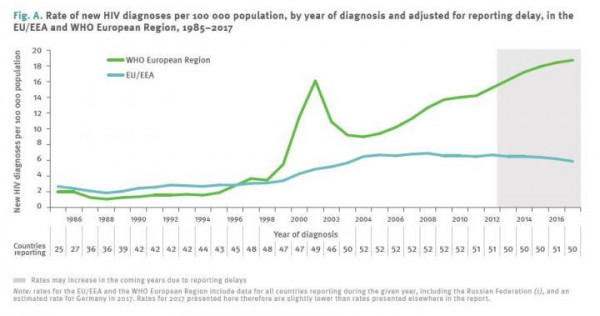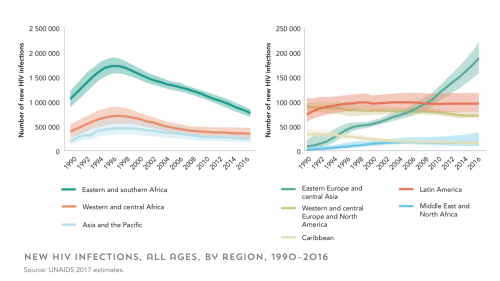HIV diagnosis rates have increased alarmingly in Eastern Europe, which includes Russia and the former Soviet bloc nations, while they have declined in Western Europe.
The European Centre for Disease Prevention and Control (EDCD) and the World Health Organization (WHO) Regional Office for Europe released new HIV diagnosis figures regarding the European Union and European Economic Area (EU/EEA) and the WHO European Region nations.
Countries in the EU include Austria, Belgium, Bulgaria, Croatia, Republic of Cyprus, Czech Republic, Denmark, Estonia, Finland, France, Germany, Greece, Hungary, Ireland, Italy, Latvia, Lithuania, Luxembourg, Malta, Netherlands, Poland, Portugal, Romania, Slovakia, Slovenia, Spain, Sweden and the United Kingdom. The EEA also includes Iceland, Liechtenstein and Norway.
The WHO European Region includes every nation from Greenland eastward, including all of Europe plus the entire former Soviet bloc. It does not include the Middle East or any non-Soviet-bloc nation south of Russia.
In 2017, 160,000 people were diagnosed with HIV in the WHO European Region. Annual diagnosis rates have increased since 2003 but not as steeply in recent years. A total of 130,000 of those diagnoses were in the eastern part of the WHO European Region, which has seen a 68 percent increase in its annual diagnosis rate since 2008.

Rate of new HIV diagnoses per 100 000 population, by year of diagnosis and adjusted for reporting delay, in the EU/EEA and WHO European Region, 1985-2017.ECDC/WHO, HIV/AIDS surveillance in Europe 2018 - 2017 data

Changes in the annual number of new HIV infections by global region according to UNAIDS. Note that this report combines Eastern Europe and central Asia.Source: UNAIDS
In the WHO European Region, 70 percent of new diagnoses in 2017 were among men. Halfof all those who tested positive for the virus had an advanced stage of HIV disease at the time, indicating that they had likely been living with the virus for years.
Rates have declined in the EU/EEA nations since 2007, including a 20 percent decrease among men who have sex with men (MSM) since 2015.
To read the report, click here.
To read a press release about the study, click here.







1 Comment
1 Comment